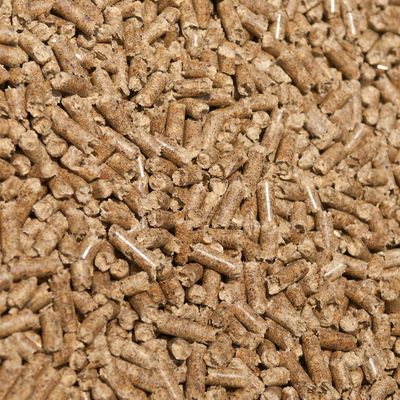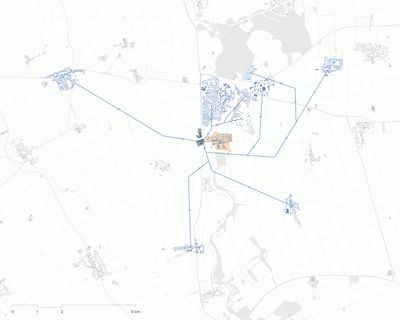AtlasBiomassNicolas Schenkel, Mischa Engeler, and Nicola Nussbaumer
In the field of energy production, the word biomass refers to organic matter used as fuel. In Germany, there are two main types of biomass fuel: biogas and solid biomass (wood). While biogas is mainly burned to generate electricity, solid biomass is burned for heating purposes. Biogas is produced by fermenting various types of organic waste from animals, plants and humans, as well as from plants grown solely to produce biogas. Generally, it is farmers who run biogas facilities because they are able to produce the biomass needed for biogas production: energy-rich crops such as corn, wheat, potatoes and sugar beets. In the Jülich Börde, with its highly fertile loess soils, the cultivation of crops for biogas production competes with agriculture for food production.
The Big Players: Wood and Biogas

Source: Frankfurter Allgemeine Zeitung.

Source: German Environment Agency (UBA), Fachagentur Nachwachsende Rohstoffe
Solid biomass and biogas are the two most important energy supplies of the biomass sector in Germany. Solid biomass which is burned and mainly used for heating, due to its high efficiency in small heating units and massive heating plants, which produce enough heat for entire cities. Nonetheless, many wood-burning plants still generate a little electricity. Biogas is organic matter which is fermented to extract the gaseous potential that lies inside of it. The biogas is then burned in a cogeneration unit. It exhibits a larger potential in electricity generation, making up the main part of electricity production from biomass. Adding to that, the residues of the fermenting process can be refined to a dry and fluid part to create two types of fertiliser for agricultural use.

WOOD-BURNING POWER PLANTS
Source: Energie-Experten, Geodatenzentrum BKG

(AGRICULTURAL) BIOGAS FACILITIES
Source: BGR, Agraratlas, DBFZ Report
Both wood-burning power plants and biogas facilities can be found across Germany. Nonetheless, some patterns in their distribution become apparent in relation to other related factors: The proximity of forested areas seems an intuitive precondition for a wood-burning plant. This assumption is however not supported by the map. Especially the large-scale wood-burning plants can be found in sparsely forested regions, such as the agricultural hotspot of Lower Saxony. Rather, some correlation between the placement of wood-burning power plants and areas of higher population can be seen. This is likely connected to the inefficiency of attempting to transport heat. Since agricultural (by-)products are the most important substrates for biogas production, there is a concentration of biogas facilities in agriculturally dominated regions. Additionally, since most biogas plants operate to generate electricity, the location close to urban centres is less relevant. Kreis Düren, in the southwest of North Rhine-Westphalia, offers both a fertile ground for agriculture and therefore also potentially for energy production from biomass.
Biogas Explained Through the Paeffgen Biogas Plant in Nörvenich

Source: EnviTec
The Paeffgen Biogas Plant in Nörvenich processes silage and manure into biogas and fertiliser. The silage arrives at the storage and is transported to the silage pit as soon as it is needed. The manure is directly filled in the correspondent pit. The silage gets shredded into grain-sized pieces and mixed with the manure into a sludgy matter. The sludge is pumped into the fermenter, where it is enriched with bacteria and oxygen, mixed and warmed to circa 37° Celsius. During the fermenting process, methane gas evolves and is stored in a gas tank. The sludge is transported to the post-fermenter, where the fermentation process continues even further. In the mechanical thickener, some of the water is extracted and brought back to the fermenter. The remaining residue can now be used as fertiliser. With the gas engine and the generator, the biogas is turned into electricity that is fed into the grid and can power Nörvenich and some nearby villages. The generated heat is used to heat the fermenter as well as a small local network of households.

PAEFFGEN BIOGAS PLANT SUBSTRATE INPUT (SCHEMATIC)
The map shows schematically the required surfaces to run the plant on its current substrate mix. The actual origins and destinations of inputs may differ.
Source: Aachener Zeitung, RWZ
- Silage corn growing area
- Animal fodder growing area
- Silage corn growing area
- Animal fodder growing area

PAEFFGEN BIOGAS PLANT ENERGY OUTPUT (SCHEMATIC)
The map shows schematically the number of households the biogas facility can supply with electricity and heating. The actual origins and destinations of outputs may differ.
Source: Aachener Zeitung, RWZ
- Local heating network
- Electricity supply
- Local heating network
- Electricity supply

Every substrate with its corresponding surfaces equals the annual demand of electricity for a village with a population of 3,865 inhabitants, which is 5,024,500 kWh. This is an extrapolation with 1,300 kWh per person as the average annual use of electricity in North Rhine-Westphalia.
Source: Fachagentur Nachwachsende Rohstoffe
Self-Sufficient Sewage Treatment Plant
The sewage treatment plant Düren-Merken cleans the sewage of several communes in the region around the city and generates electrical power as well as heat through biogas. The wastewater from domestic households, industrial wastewater and rainwater flows in the sewerage to the treatment plant. In the case of strong rainfalls the amount of water coming in exceed the plants capacity and a spare basin is used to store the excessive sewage. The larger components get screened in the bar screens and go to the refuse incineration. In the grit chamber, the grit and sand can settle and the sludgy water gets pumped into the primary clarifier where the sludge settles on the bottom while substances that are lighter than water settle on the water surface. Both get removed, the sludge is pumped into the fermenter and the sewage flows to its next destination. After the sewage gets stirred, bacteria remove foreign matter from the water. For the large number of bacteria to survive, oxygen must be added and a certain temperature must be maintained.
During the aeration and biological treatment the fluid looks sludgy because of the bacteria. The excess sludge is pumped to the fermenter, while sewage goes to the secondary clarifier. The sludge that comes with it deposits and is returned to the biological treatment basin. Finally the now nearly clarified water is filtered through active coal and flows into the Rur.
For the removed sludge the journey continues: on its way to the fermenter it gets thickened to reduce the water content. In the fermenter the sewage sludge rests for around 20 days, is mixed and heated to 37° celsius so the sludge ferments and methane gas evolves. While the remaining sludge gets dewatered and burned in the sewage sludge incinerator, the gas is stored in the gas tank and can be turned into electric energy and heat through a generator whenever needed. For the sewage treatment plant to operate much energy and heat is needed, but through the biogas production 75 % of the electric energy can be covered as well as 100 % of the heating energy.

Source: Statistisches Bundesamt und
DWA-Arbeitsgruppe KEK-1.2 Statistik





